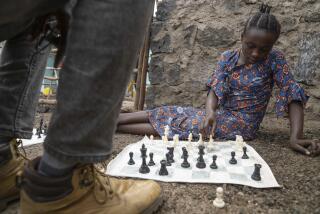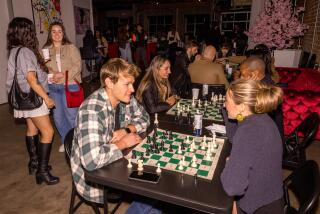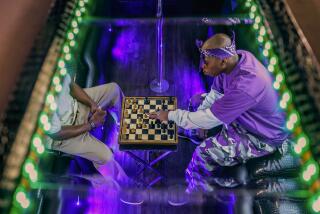Culture : Harshness of Soviet Life Is Put in Check on the Chess Board : As many as 4 million Soviets find relaxation in their time hunched over the checkered board. The Kasparov-Karpov match will be closely watched throughout the country.
- Share via
MOSCOW — Whispering so as not to break the fierce concentration of the players at the next table, 18-year-old Inna Gurtsevich tried to explain what makes her spend evenings hunched over wooden pieces on a checkered board.
“We have a very difficult life in the Soviet Union,” said the pale, delicate student, sitting in the chandeliered hall of the Moscow Chess Club. “And when I play chess, I just relax. I feel myself freed of all those lines of shoppers, of all that outside reality, and I can rest.”
In parks, in trains, in hushed clubs and quiet corners at home, Soviet chess players indulge in a national passion that appears to be more intense here than anywhere else in the world.
Up to 4 million Soviet men and women play chess seriously, officials have estimated, and countless millions more get out the board from time to time. In contrast, America counts 53,000 registered players.
Considered a full-fledged sport here rather than a hobby, and heavily subsidized, chess has developed such a powerful following that even in these days of budget cuts, its popularity continues to grow.
Escape from an ever-more-unpleasant reality may be one reason, but another is the intense rivalry between two Soviet chess titans, Gary Kasparov and Anatoly Karpov, who face off this week in New York for the world championship.
The struggle between Kasparov, 27, the current champion, who is considered brilliant but whose detractors label him an obnoxious interloper, and Karpov, 39, also brilliant but often derided as a politically orthodox “child of stagnation,” has brought the game to new heights and turned it into a symbolic clash.
“They are the personification of two worlds, one new and the other old,” said Mikhail Baitin, director of the Soviet Chess Players’ Union. “You can feel a general rise in interest, maybe because chess has become this political.”
Baitin clearly is on Kasparov’s side: On his desk lay a small bag of red, white and blue lapel pins, to be distributed in line with Kasparov’s pre-match announcement--typical of his outspoken anti-Communist stance--that he would play under the flag of Old Russia instead of the red Soviet banner with its hammer and sickle. Karpov, by contrast, is considered the Establishment player, the party’s favorite.
Karpov and Kasparov, known as “the two Ks” among chess buffs, now rule the international arena in a continuation of the Soviet domination that began after World War II and shows no sign of abating.
Soviet chess power came in part from strong traditions: Ivan the Terrible, according to some accounts, died at the chess board. Peter the Great, another Russian czar, used to force his noble guests to play, and V. I. Lenin, the Bolshevik revolutionary, was a reputed whiz at the game.
Under Soviet dictator Josef Stalin, chess became a matter of national prestige. “It was one form of propaganda, that the Soviet system can reach the highest heights in the intellectual sphere as well as in labor,” said Vladimir Umansky, secretary of the Soviet Chess Federation.
Soviet chess masters held the world title in an unbroken line from 1948 until 1972, when American prodigy Bobby Fischer defeated Boris Spassky.
That was a trauma nearly on a par with the American dismay at the Soviet launch of the world’s first satellite, and it spurred an array of crash programs and even an eventual Communist Party resolution on encouraging chess.
Over the years, tens of thousands of chess clubs have sprung up--prestigious ones such as the Moscow club, housed in a luxurious pre-revolutionary house replete with marble sculptures and inlaid tables, and more modest versions at factories and institutes. Virtually every fair-sized school has a “Chess Circle,” and the so-called Pioneer Palaces, where Soviet children go for after-school activities, teach chess technique as well. Even some kindergartens offer elementary chess.
More than 100,000 readers subscribe to Soviet chess publications, and enthusiasm is so widespread that last week, in advance of the New York championship, the Soviet equivalent of TV Guide assured its readers that there would be extremely detailed coverage, including commentaries by grand masters.
“Ahead of us is a great chess battle,” the magazine proclaimed.
Many a battle has already been waged behind the scenes in Soviet chess, mainly about control of tournaments and money.
The Kasparov camp argues that chess masters should be true professionals who subsist on their winnings and other income, taking nothing from the state and handing over none of their prize money. The Karpov school is less eager to turn down heavy government subsidies.
The semi-governmental Chess Federation has an annual budget of “several million rubles,” Umansky said, and about 1 million players take part in tournaments each year.
Chess has traditionally provided Soviet players a rare chance for major earnings, but Boris Zlotnik, head of the chess department at the Central Institute for Physical Education, said the game has a deeper appeal as well.
“There’s a popular feeling in the Soviet Union that intellect is not valued,” he said, referring to the low salaries for academic employees and poor compensation for inventors. “With chess, it’s possible to go somewhere, to get some real recognition.”
One obvious reason for chess’ popularity, Baitin noted, is that it does not require the big investments demanded by the country’s other two favorite sports, soccer and hockey. “All you need is a table, a board and some pieces,” he said.
Like the young woman at the chess club, Baitin also had a perestroika- era explanation for the emphasis on chess. “If everything here is so bad, you have to develop citizens who can bring the country out of this,” he said. “People have to learn to think a few steps ahead.”
More to Read
Sign up for Essential California
The most important California stories and recommendations in your inbox every morning.
You may occasionally receive promotional content from the Los Angeles Times.










